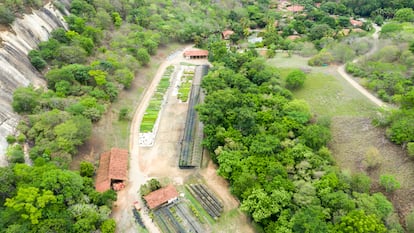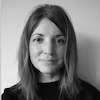‘I cried the first time I saw the Amazon, the sea of trees never ends’
The ecologist Lélia Wanick shares her passion and fear for the future of the tropical forest with EL PAÍS, after receiving the Gulbenkian Prize for Humanity. Alongside her husband — the photographer Sebastião Salgado — she reforested more than 1,700 acres of land in her native Brazil

This past July, 76-year-old Lélia Wanick was awarded the Gulbenkian Prize for Humanity in Lisbon, Portugal, for restoring a degraded forest in her native Brazil. Her husband — the renowned photographer Sebastião Salgado — was so excited that he forgot to take any pictures.
“Can you believe it? I took my private photographer and I didn’t get a photo,” Wanick laughed, teasing her partner affectionately. They have been together for six decades.
The interview with EL PAÍS took place shortly after she received the award. Her eyes lit up as soon as she began to talk about her rainforest. “It’s wonderful, impressive, important.”
For their entire lives, Wanick and Salgado have worked together. Both have an artistic background — he’s a photographer, while she designs his books and exhibitions — and an environmental one. Both of them have tried to protect the biodiversity of their country.
At the end of the 1990s, they acquired the Bulcão farm, in Aimorés, located in the southeastern Brazilian state of Minas Gerais. This consisted of more than 1,700 acres of degraded land, which had belonged to Wanick’s in-laws. Today, it’s an orchard of 2.7 million trees and abundant fauna, home to the Terra Institute, which they founded in 1998 for forest restoration. The institute also acts as a research and training center.
“I received the award, but we did this together,” Wanick emphasized. And together, they’ll be inaugurating the 13th photo exhibition of Amazônia in Madrid, which includes six years of their work. It conveys the beauty and fragility of the tropical forest — without which life on this planet wouldn’t be possible — and part of the lives of its inhabitants, who protect it.
Question. When did you go to the Amazon for the first time?
Answer. A long time ago. I felt the force of nature and that we’re part of it. It was very intense. I was so moved that I cried when I saw that wonder, that forest, a sea of trees that never ends. Although, of course, it can disappear.
Q. Is that the feeling you sought when selecting the photographs for the exhibition?
A. Our goal — when we started this project — was to show the Amazon as it is: beautiful, wonderful, splendid. And to make people realize that they must help protect it.
Q. Why?
A. There’s an aspect of the Amazon that [consists of its] aerial rivers: the evaporation of this water forms clouds, very large and heavy, carrying the humidity here, to Europe. If the Amazon is lost, all the moisture on the planet is lost.
Q. Many people don’t know how to help protect it.
A. There’s something that everyone can do: look at the origin of the products we buy. If Brazilian meat comes from the Amazon, that means trees and plants were cut down to raise the cattle. It’s not necessary — Brazil has enough land. But, every year, the farms eat a piece of this jungle. It’s incredible. All ranchers should know why the forest is there, why it needs to exist. If they knew, they wouldn’t [do what they do]. Fortunately, today, we have a [Brazilian] government that takes the Amazon into account, that has recovered the institutions that care about it and the Indigenous people.

Q. How did four years of Jair Bolsonaro affect you?
A. It wasn’t Bolsonaro who began to destroy the Amazon. But, in recent years, many [trees] were cut down, allowing people to enter the land of the Indigenous people to extract gold, to kill them. Fortunately, that’s over.
Q. In addition to raising awareness with photography, you have restored a forest. How did you do this?
A. We bought some land from Sebastião’s parents, who were older and didn’t want to sell it to strangers. One day, I had the magnificent idea of restoring the forest. My husband liked it a lot. We started thinking about reforesting in 1996, but we needed people to help us decide which species to plant and where to plant them. It took two more years of hard work, many conversations... my father-in-law thought we were crazy for wanting to create a forest, but he lived two or three more years to see the smallest plants. In 1998, we founded the Terra Institute.
Q. Sebastião Salgado says that, in his childhood, the farm was all green. Why did it deteriorate so much?
A. It was used for agriculture and, when the land ran out, [it was used for] cattle, cattle and more cattle. Imagine a 1,300-pound animal that, when it walks, boom, boom, boom, it hardens the earth. Not even the grass grows again. Things were changing for the worse.
When Sebastião was young, the small town next door had two boarding schools: one for girls and one for boys. The children of the rural landowners went there, the ones who had money to pay. Then, they became poor. The land became impoverished. The schools closed. The philosophy of our school is to make people think that we can restore the planet if we want to.
Q. You weren’t satisfied with just restoring the Bulcão farm.
A. We thought about how we were going to make a wonderful garden and forest, and that everything around it was going to be horrible. We had to intervene further. This is how we founded the Terra Institute, to provide environmental education, to try to plant trees on neighboring land, to restore water. Today, this continues to be our mission.
Q. A quarter-of-a-century later, what is this paradise like?
A. That’s exactly what it is, it’s a paradise. With 50-foot trees. It’s amazing how the animals came back. We have jaguars now! They came because they have the entire food chain available. We have macaques, 172 documented species of birds... it’s impressive. Last week, we were at the institute, and we saw a big capybara — he was listening to our talk. It was wonderful, he was eating my plants (laughs).
Q. You’ve won many awards for this reforestation and conservation work. The last one — the Gulbenkian Prize for Humanity — gave out one million euros to be distributed among the three winners.
A. It’s wonderful to receive this award, because the institution gains international visibility. And also money. It’s very important for the continuity of the Terra Institute.
Q. How is the Terra Institute financed?
A. Through projects that corporations support. We’ve received a donation from the Zurich Insurance Group, a Swiss company, to buy surrounding farms and increase the size of our forest and restore the streams. It’s very important for the animals, because they’ll now have water to drink. But, there’s a part of the institute that nobody pays for: everyday things, electricity, the salary of the director, the cleaners… for all of this, we created an endowment with the King Baudouin Foundation of Belgium. We’ve been putting money into this fund for two years. The prize money will go directly there too, to guarantee its perpetuity. If we ever run out of money for programs, we can pull some out from there and continue our mission.
Q. Are you concerned about the continuity of the project?
A. We’re getting older and we don’t know when, but our day will come. This legacy is very valuable to everyone. Our son has assumed the presidency of the council. I’m a woman at peace.
Q. What legacy are you most proud of: artistic or environmental?
A. The environmental legacy. And the artistic side also has that environmental aspect, but it’s not concrete. The forest is concrete: the water is there, the animals are there. With photographs, you can reach a lot of people, that’s true… but the planet needs forests. They’re more important.
Q. But with your work in photography, you’ve also contributed to protecting the Amazon.
A. Yes, of course. In photography, when you see something that moves you — because it’s very beautiful, ugly, or sad — it can transform you. I have proof: we receive so many letters from people who say that they will try to do something [after seeing our pictures]. Some three million people have seen the Amazônia exhibition… many of them have sent messages saying that they didn’t know that the Amazon had so many mountains, they didn’t know it was so wonderful. The highest mountain in Brazil — Pico da Neblina [Peak of the Clouds] — is there. It’s almost 10,000 feet tall.
The Gulbenkian Foundation paid for the journalist to travel to Lisbon to conduct this interview.
Tu suscripción se está usando en otro dispositivo
¿Quieres añadir otro usuario a tu suscripción?
Si continúas leyendo en este dispositivo, no se podrá leer en el otro.
FlechaTu suscripción se está usando en otro dispositivo y solo puedes acceder a EL PAÍS desde un dispositivo a la vez.
Si quieres compartir tu cuenta, cambia tu suscripción a la modalidad Premium, así podrás añadir otro usuario. Cada uno accederá con su propia cuenta de email, lo que os permitirá personalizar vuestra experiencia en EL PAÍS.
¿Tienes una suscripción de empresa? Accede aquí para contratar más cuentas.
En el caso de no saber quién está usando tu cuenta, te recomendamos cambiar tu contraseña aquí.
Si decides continuar compartiendo tu cuenta, este mensaje se mostrará en tu dispositivo y en el de la otra persona que está usando tu cuenta de forma indefinida, afectando a tu experiencia de lectura. Puedes consultar aquí los términos y condiciones de la suscripción digital.
More information
Archived In
Últimas noticias
Most viewed
- Sinaloa Cartel war is taking its toll on Los Chapitos
- Oona Chaplin: ‘I told James Cameron that I was living in a treehouse and starting a permaculture project with a friend’
- Reinhard Genzel, Nobel laureate in physics: ‘One-minute videos will never give you the truth’
- Why the price of coffee has skyrocketed: from Brazilian plantations to specialty coffee houses
- Silver prices are going crazy: This is what’s fueling the rally











































